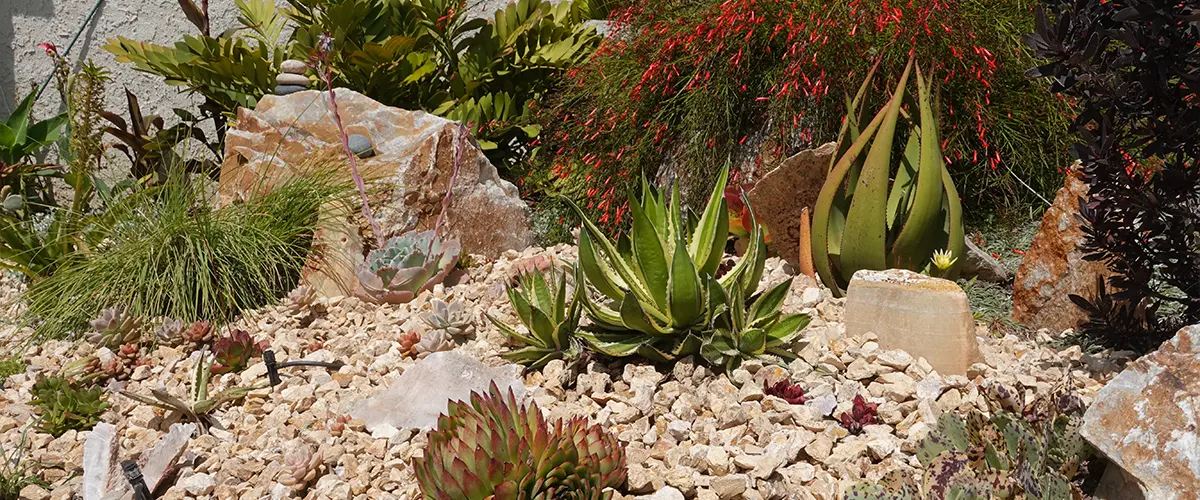Are you trying to find a low-maintenance landscaping solution for your home?
If so, chances are you have heard of the terms zeroscape and xeriscape. It can be difficult to understand the technical jargon associated with landscaping and gardening.
Luckily, we’re here to help explain what each term means and how they differ from one another to provide clarity on the best way to maintain a backyard oasis that is both eye-catching and sustainable!

What Is Xeriscaping?
The origins of xeriscaping date back to the late 70s, when the Front Range Xeriscape Task Force of Denver Water came up with the term. Combining the Greek word for dry, “xeros,” with “landscape,” they created a solution to help reduce water consumption and maintain green spaces in drier climates.
The City of Denver even went as far as trademarking the term and initiating lawsuits against those who used it without permission. However, as more and more municipalities adopted the concept, the trademark issue was eventually relaxed. Today, xeriscaping continues to be a sustainable and innovative approach to landscaping in arid regions.
Imagine creating your own oasis in your backyard, with lush and thriving plant life surrounding a beautiful outdoor living area. A xeriscape garden is focused on organized landscape design with thriving drought-tolerant plants combined with zero-maintenance river rock.
With hydrozoning, you can strategically zone your irrigation system to deliver just the right amount of water to each area of your landscape, conserving water where it’s not needed and ensuring that your oasis stays hydrated and thriving.
Not only will you be able to enjoy the areas where you spend the most time, but you’ll also be doing your part to conserve water and protect the environment.

What Is Zeroscaping?
There are lots of contradicting opinions on the definition of zeroscape landscapes. Some claim that zeroscaping is just a mispronunciation of xeriscaping. Others claim it’s a more basic form of xeriscaping, as it involves creating a dry landscape design, eliminating native plants from the scenery.
Don’t be mistaken, zeroscape is not the same thing – it’s a bleak, desolate landscape of nothing but gravel and the occasional boulder, without the presence of other plants.
Let’s bring life back to our yards and show off the breathtaking environment we call home!
The Importance of Plant Selection for Xeriscaping
Creating efficient irrigation hydrozones and sustainable desert landscapes is more than just randomly grouping plants. In fact, improper placement can lead to the demise of your beloved flora.
- To avoid being cruel to flowers from humid climates, knowing which plants thrive in which locations is crucial. For instance, flowering plum and Japanese privets should not be placed against the west-facing wall of your home.
- Incorporating the oasis concept into your landscaping is a surefire way to create a stunning and sustainable outdoor space. By strategically placing lush plants and grass near your living area, you can optimize your water consumption while still enjoying a beautiful environment.
- It's important to be mindful of the size of your oasis in order to conserve water and ultimately save money. When selecting plant varieties, prioritize those that are suited to the climate and intended use of the area.
- And don't worry about rigidly adhering to traditional landscaping aesthetics - opt for tough, resilient plants in the most challenging areas of your yard. With the oasis concept, sustainable landscaping is practical and leads to a beautiful yard.

Who Benefits From a Xeriscape Yard?
As a homeowner, you can save money on your water bill and free up time from maintaining your traditional landscape. Plus, your home’s value can increase with an attractive xeriscape design.
When it comes to the environment, xeriscaping helps save water, reduces the use of harmful chemicals, and creates homes for native wildlife.
Municipalities can also benefit from reduced water demand, avoiding costly infrastructure projects, and lessening their water usage. Businesses can even get in on the action by saving money on their water bills and showcasing their commitment to sustainability.
Final Thoughts
Xeriscapes use both hardscaping and native plants strategically chosen for drought-tolerant species that will fare well in harsh climate conditions. Plant selection is critical for the success of a xeriscape since not all plants can withstand reduced water intake.
The benefits of a xeriscape are numerous: low maintenance, low water consumption, often no fertilizers or pesticides needed, increased property value and simply having an aesthetically pleasing landscape instead of a barren desert-like yard!
Everyone from small urban space owners to homeowners on sprawling estates can enjoy the beauty of a low-maintenance acreage with minimal watering needs when making the switch to xeriscaping.
Here at Crush, we’re experts in xeriscaping and creating pristine spaces that our customers fall in love with at first sight. We’re reasonably priced and reliable xeriscaping contractors that serve Bennett, Watkins, Aurora, Strasburg, and Denver, CO.
Give us a call today at (720) 507-4076 or request your free quote now!
